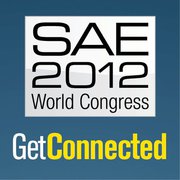
“The SAE 2012 World Congress theme, Get Connected, represents the new and diverse connections that will drive significant advancements in the auto industry of tomorrow. Not only does the theme symbolize literal connections, such as those between vehicles, infrastructure, the Internet, and the nation’s electrical grid, but also demonstrates the most fundamental of connections; the connections and relationships between engineers who are developing the next generation vehicle technology.”
To understand how mesh morphing can help shape optimization you can’t miss this presentation about the 50:50:50 project:
TUESDAY, APRIL 24 – MORNING
Technical and Business Sessions D3-24/25 Vehicle Aerodynamics (Part 1 of 6): Aerodynamic Development I (B500)
11:00 a.m.
An Accurate, Extensive, and Rapid Method for Aerodynamics Optimization: The 50:50:50 Method (2012-01-0174)
Ashok Khondge, Ansys India; Sandeep Sovani, ANSYS Inc.
Abstract
Computational Fluid Dynamics (CFD) is widely used in vehicle aerodynamics development today, but typically used to study one vehicle shape at a time.
In order to be used for aerodynamic shape exploration and optimization the CFD simulation process has to be able to study a large set of design alternatives (vehicle shape variants) within the short period of time typically available in the overall aerodynamics development process.
This paper reports the development and testing of a process, referred to as the 50:50:50 Method, which is developed to study a large set of design alternatives in a highly automated way, while ensuring that each design alternative is simulated with a high fidelity CFD simulation.
The process leverages morphing, advanced CFD solver numerics, high performance computing, and process automaters to simulate 50 shape variants of a vehicle, with high fidelity CFD simulations that use a computational mesh of 50 million cells for simulating each design point, in a total elapsed time of 50 hours after initial case setup.
The development of this process and a test case with a realistic vehicle are reported.



